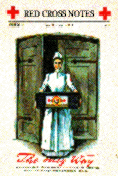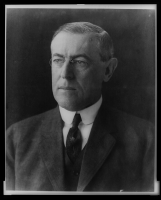The Influenza Pandemic of 1918:
The Impact of the Influenza Pandemic on the Military
Molly Billings and Jeremy Schneider
The origins of the deadly flu disease were unknown but widely speculated upon. Some of the allies thought of the epidemic as a biological warfare tool of the Germans. Many thought it was a result of the trench warfare, the use of mustard gases and the generated "smoke and fumes" of the war. A national campaign began using the rhetoric of war to fight the new microscopic enemy. A study attempted to reason why the disease had been so devastating in certain localized regions, looking at the climate, the weather and the racial composition of cities. They found humidity to be linked with more severe epidemics as it "fosters the dissemination of the bacteria," (Committee on Atmosphere and Man, 1923). Meanwhile the new sciences of the infectious agents and immunology were racing to come up with a vaccine or therapy to stop the epidemics.
The deadly flu is thought to have originated in China in a rare genetic shift of the influenza virus. The recombination of its surface proteins created a virus novel to almost everyone and a loss of herd immunity. The virus has been reconstructed from the tissue of a dead soldier and genetically characterized. The name of Spanish Flu came from the early affliction and large mortalities in Spain (BMJ,10/19/1918) where it allegedly killed 8 million in May (BMJ, 7/13/1918). However, a first wave of influenza appeared early in the spring of 1918 in Kansas and in military camps throughout the US. Few noticed the epidemic in the midst of the war. Wilson had just given his 14 point address. There was virtually no response or acknowledgment to the epidemics in March and April in the military camps. It was unfortunate that no steps were taken to prepare for the usual recrudescence of the virulent influenza strain in the winter. The lack of action would later be criticized when the pandemic hit in the winter of 1918 (BMJ, 1918). These first epidemics at training camps were a sign of what was coming in greater magnitude in the fall and winter of 1918 to the entire world.
The war brought the virus back into the US for the second wave of the epidemic. It first arrived in Boston in September of 1918 through the port busy with war shipments of machinery and supplies. The war also enabled the virus to spread and diffuse. Men across the nation were mobilizing to join the military and the cause. As they came together, they brought the virus with them and to those they contacted. The virus killed almost 200,000 in October of 1918 alone. The end of the war on November 11, 1918 enabled a resurgence in many cities, as people celebrated Armistice Day with parades and large parties. That winter, the flu infected millions and killed thousands. Just as the war had affected the course of influenza, influenza affected the course of the war. Entire fleets were ill with the disease and men on the front were too sick to fight. The flu was devastating to both sides, killing more men than military weapons could.

With the military patients coming home from the war with battle wounds and mustard gas burns, hospital facilities and staff were taxed to the limit. This created a shortage of physicians, especially in the civilian sector, as many had been lost for service with the military. Since the medical practitioners were away with the troops, medical students were left to care for the sick. Third and fourth year classes were closed and the students were assigned jobs as interns or nurses (Starr,1976). One article noted that "depletion has been carried to such an extent that the practitioners are brought very near the breaking point," (BMJ, 11/2/1918). The shortage was further confounded as physicians themselves were infected and succumbed to the epidemic. In the U.S., the Red Cross had to recruit more volunteers to contribute to the new cause at home of fighting the influenza epidemic. To respond with the fullest utilization of nurses, volunteers and medical supplies, the Red Cross created a National Committee on Influenza. It was involved in both military and civilian sectors to mobilize all forces to fight Spanish influenza (Crosby, 1989). In some areas of the US, the nursing shortage was so acute that the Red Cross had to ask local businesses to allow workers to have the day off if they volunteered in the hospitals at night (Deseret News). Emergency hospitals were created to take in the patients from the US and those arriving sick from overseas.
 The pandemic
affected everyone. With one-quarter of the US and one-fifth of the world
infected with the deadly influenza, it was impossible to escape from the
illness. Even President Woodrow Wilson suffered from the flu in early 1919
while negotiating the crucial treaty of Versailles to end the World War
(Tice). Those who were lucky enough to avoid infection had to deal with
the public health ordinances to restrain the spread of the disease. The
public health departments distributed
gauze masks to be worn in public. Stores could
not hold sales, funerals were limited to 15 minutes. Some towns required
that people obtain a signed certificate in order to enter and railroads
would not accept passengers without them. Those who ignored the flu ordinances
had to pay steep fines enforced by extra officers (Deseret News). Bodies
piled up as the massive deaths of the epidemic ensued. Besides the lack
of health care workers and medical supplies, there was a shortage of coffins,
morticians and gravediggers (Knox). These conditions in 1918 recalled those
of the Middle Ages, when the Black Death caused by the bubonic plague claimed
nearly two-thirds of European lives.
The pandemic
affected everyone. With one-quarter of the US and one-fifth of the world
infected with the deadly influenza, it was impossible to escape from the
illness. Even President Woodrow Wilson suffered from the flu in early 1919
while negotiating the crucial treaty of Versailles to end the World War
(Tice). Those who were lucky enough to avoid infection had to deal with
the public health ordinances to restrain the spread of the disease. The
public health departments distributed
gauze masks to be worn in public. Stores could
not hold sales, funerals were limited to 15 minutes. Some towns required
that people obtain a signed certificate in order to enter and railroads
would not accept passengers without them. Those who ignored the flu ordinances
had to pay steep fines enforced by extra officers (Deseret News). Bodies
piled up as the massive deaths of the epidemic ensued. Besides the lack
of health care workers and medical supplies, there was a shortage of coffins,
morticians and gravediggers (Knox). These conditions in 1918 recalled those
of the Middle Ages, when the Black Death caused by the bubonic plague claimed
nearly two-thirds of European lives.
As the pandemic began to spread in 1918-19, nations were already overwhelmed by the costs of the war. Propaganda campaigns and war restrictions and rations had been implemented by governments. Nationalism pervaded and most people were more willing than ever to accept government authority. This allowed the public health departments to easily step in and implement their restrictive measures. Most governments at this time became increasingly dependent on scientists, who were now armed with the new germ theory and the development of antiseptic surgery. Scientists led efforts to design vaccines and reduce mortalities of disease and battle wounds. Their new technologies could preserve the men on the front and ultimately save the world.
-
ons of the influenza pandemic on the military:
A letter to a fellow physician describing conditions during the influenza epidemic at Camp Devens
A collection of letters of a soldier stationed in Camp Funston Soldier